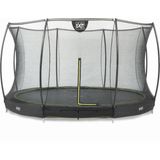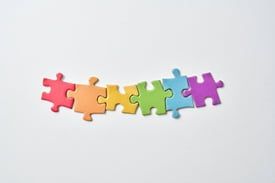Piece By Piece Puzzle Happiness
Why a puzzle is more relaxing (and above all cheaper!) than a thermal bath trip, where the material comes from, what jigsaw puzzles do to our brains and how you can find enlightenment as a future puzzle game guru - read on for answers to these and other urgent questions.
There was once …
The English engraver John Spilsbury (1739-1769) is considered to be the inventor of the puzzle. He put a map of Great Britain on a wooden board and sawed it up along the boundaries of the counties. He sold his invention as a "teaching aid to facilitate geography lessons". Other models followed. By the way, the English term “jigsaw puzzle” goes back to this early production method.
It was not until a good 100 years later that the interlocking shape of the puzzle pieces, which is common today, appeared. From the beginning of the 20th century, jigsaws were mass-produced. Thanks to the much cheaper price, jigsaws became a popular pastime.
To date, not much has changed in the manufacturing process. The motif is printed on cardboard and cut into small parts with a punch. More and more precise punches ensure that the parts fit really well and can't be incorrectly forced together. Colour and print quality are also making great progress, making them more and more attractive.

Make one out of two
As is generally known, our brains are made up of two halves. The one on the left is known as a tough analyst, the one on the right as an intuitive creative. When both halves are activated at the same time, the connection between the individual cells is strengthened. As a result, the efficiency and capacity of our thinking centre increase. When doing jigsaws, as you have probably already guessed, we simultaneously activate both parts.
Brain training for all ages
The brain is often referred to colloquially as a muscle. If it is used regularly and intensively, its performance improves. With the so-called “scanning” of puzzle pieces, you get an overview of shape, colour and the resulting possible placement areas. This process, which happens over and over again while playing, is hard work for our grey cells. Short-term memory, concentration, imagination and visualisation skills are all trained at the same time! It also reduces the likelihood of Alzheimer's disease or dementia.
Oooooooommmmmm
While your thinking apparatus achieves its ultimate performance in puzzle-laying, the rest of your body shifts down a gear and relaxes. Almost like a meditation, the constant visualisation blocks out other stimuli. You get into a flow and are completely absorbed in the task. As your heart rate, respiratory rate, and blood pressure drop, everything feels effortless. In the moment of total concentration, every move happens by itself.

The purest child's game
It's probably not so easy for the grown-ups to understand, but little hands don't always do what children want them to do. Grasping the puzzle pieces and putting them in the correct place promotes fine motor skills. Eye-hand coordination is also trained while doing puzzles. Speaking of school ...
To a large extent, school lessons must focus on conveying facts and figures. The structured and analytical thinking on which the puzzle is based comes in handy here. In real life, it is important to break down demanding tasks into individual steps, organize them according to parameters and then gradually master them. These processes are trained at your own pace and without external pressure when doing jigsaws.
Happiness wants to be found
Sometimes it's like magic. The piece of the puzzle you are looking for is nowhere to be found and perseverance is required. If you don't give up, finally find the item (at some point everything will reappear) and proudly put it in place, you will be rewarded with a load of dopamine. The happiness hormone is released with every correctly placed part. This way, the puzzle remains motivating, improves stamina and puts you in a good mood.

Tips for newbies
It may sound banal, but a solid surface and lots of light are basic requirements for a successful puzzle adventure so it's best to sit down at a table. Good lighting helps when scanning the parts. If there is not enough space, we recommend your own puzzle mat so you can easily and safely transport your work of art if you need the table surface for something else.
Beginners can start with a motif that has many different colours, patterns and details, allowing children to quickly can see which part belongs where. For young people and adults, we recommend a maximum of 500 parts to start with. With a little experience, dare to work on more difficult motifs with up to 1000 pieces. Variants with 2000 or more pieces are intended for experienced puzzle professionals.
So, when the table is prepared and the right jigsaw with a great motif is in front of you - what now? To get off to a good start, first find out all the edge parts to lay the frame. Once you've done that, sort the remaining pieces by colour, pattern or shape. After that, the only thing that helps is constant scanning and testing until the last part is in place. Just take your time, stay focused and find your flow. As every jigsaw guru will assure you: The journey is the destination.
Latest reviews
-
 5.0 (2)
5.0 (2)Schleich 13952 - Horse Club - Paso Peruano Stallion
- Fabulous gait
- Elegant posture
- Size: 14 x 3.5 x 10.5 cm
£8.85Delivery by January 07
-
 5.0 (1)
5.0 (1)Schleich 42535 - Horse Club - Adventure With Car And Horse Trailer
- High-quality play figures
- For playing and learning
- Size: 50 x 20 x 22cm
£70.00Not available at the moment
-
 5.0 (1)
5.0 (1)Schleich 42481 - Farm World - Pony Agility Training
- Great obstacles
- Movable figure
- Colourful design
£34.50Not available at the moment
-
 2.0 (1)
2.0 (1)Exit Toys Silhouette Ground Trampoline Ø 427 cm, Black
-21%- High-quality material
- Large surface
- Safe fun
£388.74 £493.02Delivery by January 07
Magazine Articles:
-
Great Britain: Free standard delivery from £69.90
-
Free
returns More than 6.500 products
Secure payments
with SSL encryption technology

